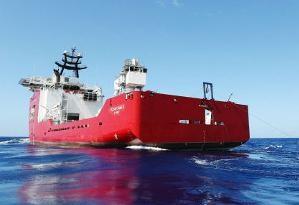April 5, 2014
PERTH: China's official news agency says a Chinese ship that is part of the multinational search effort looking for the missing Malaysia Airlines plane has detected a "pulse signal" in southern Indian Ocean waters.

April 5, 2014
PERTH: China's official news agency says a Chinese ship that is part of the multinational search effort looking for the missing Malaysia Airlines plane has detected a "pulse signal" in southern Indian Ocean waters.

Australian ship Ocean Shield in the first search for the flight data recorder and cockpit voice recorder of the missing Malaysia Airlines Flight MH370 in the southern Indian Ocean.
The report says a black box detector deployed by the vessel, Haixun 01, picked up a signal at 37.5Hz per second on Saturday at around 25 degrees south latitude and 101 degrees east longitude.
The report said it was not established whether that the signal was related to the missing jet.
The Australian government agency coordinating the search would not immediately comment on the report.
'Won't give up search'
Meanwhile, Malaysia vowed on Saturday that it would not give up on trying to find the missing jetliner and announced details of a multinational investigation team to solve the aviation mystery, as the search for the plane entered its fifth week.
Military and civilian planes, ships with deep-sea searching equipment and a British nuclear submarine scoured a remote patch of the southern Indian Ocean off Australia's west coast, in the increasingly urgent hunt for debris and the "black box" recorders that hold vital information about Malaysia Airlines Flight 370's last hours.
After weeks of fruitless looking, officials face the daunting prospect that sound-emitting beacons in the flight and voice recorders will soon fall silent as their batteries die after sounding electronic "pings" for a month.
Hishammuddin Hussein, Malaysia's defence minister and acting transport minister, told reporters in Kuala Lumpur that the cost of mounting the search was immaterial compared to providing solace for the families of those on board by establishing what happened.
"I can only speak for Malaysia, and Malaysia will not stop looking for MH370," Hishammuddin said.
The Boeing 777 disappeared March 8 while en route from Kuala Lumpur to Beijing with 239 people aboard. So far, no trace of the jet has been found.
At the media briefing, Hishammuddin announced that an independent investigator would be appointed and three main areas of inquiry would be pursued. One team will look at airworthiness, including maintenance, structures and systems; another will examine operations, such as flight recorders and meteorology; and a third will consider medical and human factors.
The overall investigation team will include officials and experts from Australia — which as the nearest country to the search zone is currently heading the hunt, with other nations' help — as well as China, the United States, Britain and France, Hishammuddin said.
A multinational team is desperately trying to find debris floating in the water or faint sound signals from the recorders that could lead them to the missing plane and unravel the mystery of its fate.
Finding floating wreckage is key to narrowing the search area, as officials can then use data on currents to backtrack to where the plane hit the water, and where the flight recorders may be.
Beacons in the black boxes emit "pings" so they can be more easily found, but the batteries only last about a month.
Officials have said the hunt for the wreckage is among the hardest ever undertaken, and will get much harder still if the beacons fall silent before they are found.
"Where we're at right now, four weeks since this plane disappeared, we're much, much closer," said aviation expert Geoffrey Thomas, the editor in chief of AirlineRatings.com. "But, frustratingly, we're still miles away from finding it. We need to find some piece of debris on the water; we need to pick up the ping."
If it doesn't happen, the only hope for finding the plane may be a full survey of the Indian Ocean floor, an operation that would take years and an enormous international operation.
Hishammuddin said there were no more new satellite images or data that can provide new leads for searchers. The focus now is fully on the ocean search, he said.
Two ships, the Australian navy's Ocean Shield and the British HMS Echo, carrying sophisticated equipment that can hear the recorders' pings, returned on Saturday to an area investigators hope is close to where the plane went down. They concede the area they have identified is a best guess.
Up to 13 military and civilian planes and nine other ships took part in the search Saturday, the Australian agency coordinating the search said.
Because the US navy's pinger locator can pick up signals to a depth of 6,100 meters (20,000 feet), it should be able to hear the plane's data recorders even if they are in the deepest part of the search zone — about 5,800 meters (19,000 feet). But that's only if the locator gets within range of the black boxes — a tough task, given the size of the search area and the fact that the pinger locator must be dragged slowly through the water at just 1 to 5 knots (1 to 6mph).
Australian Air Chief Marshal Angus Houston, head of the joint agency coordinating the operation, acknowledged the search area was essentially a best guess, and noted the time when the plane's locator beacons would shut down was "getting pretty close."
The overall search area is a 217,000-square-kilometer (84,000-square-mile) zone in the southern Indian Ocean, about 1,700 kilometers (1,100 miles) northwest of the western Australian city of Perth.
Courtesy: AFP
















































































































